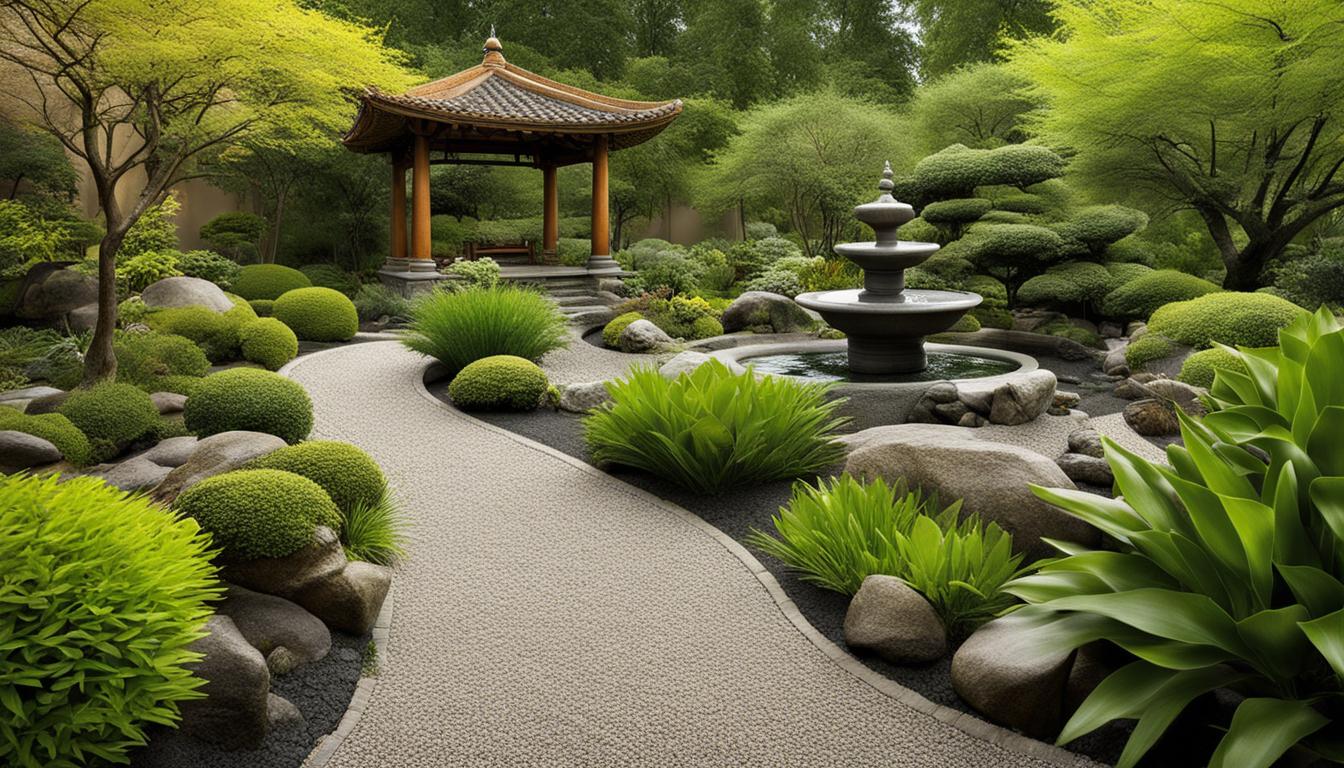Originally posted on October 28, 2023 @ 10:46 pm
Welcome to our comprehensive guide on how to balance Feng Shui elements to create harmony and positive energy in your home. Achieving Feng Shui equilibrium can be a daunting task, but with our expert tips and techniques, you can learn how to harmonize the five elements effortlessly.
Creating a balanced Feng Shui environment involves understanding the concept of Feng Shui and how it can be used to bring balance and peace into your home. In this guide, we will explore the five elements of Feng Shui – wood, fire, earth, metal, and water – and how balancing these elements can optimize the flow of energy in your space. We will also cover techniques for decluttering and assessing your space, as well as ways to incorporate Feng Shui principles in different rooms.
Key Takeaways:
- Understanding the concept of Feng Shui is essential for achieving balance and harmony in your home.
- The five elements of Feng Shui – wood, fire, earth, metal, and water – each represent different energies and must be harmonized for optimal energy flow.
- Assessing your space and decluttering is crucial for creating a balanced Feng Shui environment.
- By incorporating Feng Shui principles in different rooms, you can promote relaxation, productivity, and overall well-being.
- Learning how to balance Feng Shui elements can effortlessly transform your living space into a sanctuary of balance, peace, and well-being.
What is Feng Shui?
Feng Shui is an ancient Chinese practice that involves arranging your living space to create a harmonious flow of energy. By harmonizing energy using Feng Shui principles, you can bring a sense of balance and peace into your home, enhancing your overall well-being.
Translated as “wind-water,” Feng Shui focuses on the balance of yin and yang energies and the five elements – wood, fire, earth, metal, and water – to create a harmonious environment.
To achieve a balanced and positive energy flow in your home, here are some Feng Shui balance tips to consider:
- Declutter your space to allow energy to flow freely,
- Introduce natural light and air into your home,
- Choose furniture and decor that promotes relaxation and comfort,
- Use colors and materials that correspond to the elements of Feng Shui,
- Arrange furniture and objects in a way that optimizes the flow of energy.
By incorporating these Feng Shui principles, you can create a living environment that feels balanced, peaceful, and rejuvenating.

The Five Elements in Feng Shui
In Feng Shui, everything in the universe is composed of five elements: wood, fire, earth, metal, and water. Each element is associated with specific characteristics and energies and has its own unique representation.
The elements interact with each other, creating a dynamic energy flow that can affect the environment and the people living in it. Maintaining a balance of these elements in your home is essential to create a harmonious and peaceful living space.
The following table outlines the characteristics and associations of each element:
| Element | Characteristics | Association |
|---|---|---|
| Wood | Growth, expansion, flexibility, and vitality. | Plants, flowers, green color, rectangular shapes. |
| Fire | Passion, transformation, and dynamic energy. | Candles, lights, red color, triangular shapes. |
| Earth | Stability, nourishment, and grounding. | Crystals, rocks, beige and brown colors, square shapes. |
| Metal | Clarity, precision, and efficiency. | Metal objects, white and gray colors, circular shapes. |
| Water | Calmness, relaxation, and abundance. | Water features, blue and black colors, wavy shapes. |
Each element has a unique energy that can affect the energy flow in your home. It is important to maintain a balance of these elements to create a harmonious and peaceful living environment.
Assessing Your Space
Before implementing Feng Shui techniques, it is crucial to assess every space in your home. Feng Shui is all about creating harmony and balance, so you must evaluate your surroundings to identify areas that require balance. Here are some tips for assessing your space:
- Start with a clean slate- Begin by decluttering and getting rid of anything that does not serve a purpose or bring you joy. Decluttering helps create space and encourages positive energy flow.
- Consider the purpose of each room- Each room in your home serves a unique purpose, and the energy flow should reflect that. For example, the energy in your bedroom should promote relaxation, while the energy in your workspace should encourage productivity.
- Balance Yin and Yang- Yin and Yang are opposing forces that must be balanced for harmony to exist. Yin represents darkness, rest, and femininity, while Yang represents light, activity, and masculinity. Make sure there is a balance of both energies in each room.
- Assess natural light sources- Natural light is essential for health and well-being. Ensure that each room has adequate natural light and that window treatments allow for maximum light flow.
- Examine the color palette- Colors have energy and can impact mood and emotions. Consider the energy you want to create in each room and choose colors that align with that energy. Use warm colors like orange and yellow for a cozy energy and cool colors like blue and green for a calming energy.
By assessing your space, you can identify imbalances and make appropriate adjustments to create a harmonious and peaceful environment.

Balancing the Wood Element
Wood is an essential element of Feng Shui and represents growth, flexibility, and vitality. Incorporating the wood element into your living space can create a sense of balance and harmony.
To balance the wood element in your home, consider adding furniture and decor made from wood. A wooden coffee table or bookshelf can bring the energy of nature inside and create a peaceful atmosphere.
You can also add objects with a vertical shape, such as plants or tall lamps, to represent the upward growth of wood. Green is the color of the wood element, so adding plants and green accents can also bring balance and harmony to your space.

Another way to balance the wood element is by incorporating the water element, which nourishes the growth of wood. A small table fountain or an aquarium can bring flowing water into your space and help balance the energy.
Remember, balance is key when it comes to Feng Shui. Avoid overdoing it with the wood element, as too much can lead to an excess of energy and cause imbalance in your living space.
Harnessing the Power of Fire
The fire element in Feng Shui represents passion, energy, and transformation. By incorporating fire-inspired decor and colors, you can infuse your space with warmth and vitality.
Here are some tips for balancing the fire element in your home:
- Add candles or a fireplace to create a cozy atmosphere.
- Choose red, orange, or yellow accents to infuse your space with energy.
- Avoid going overboard with fire element objects, as too much fire can create an overly stimulating environment.
If you have a fireplace, it should be the focal point of the room. Arrange furniture around it to create a comfortable gathering space. However, if you don’t have a fireplace, you can add visual warmth and energy through carefully placed lighting and decor.
Fire Element in the Bedroom
The bedroom is a place for rest and relaxation, but that doesn’t mean you can’t incorporate the fire element in this space. However, be careful not to overdo it, as too much fire can create restlessness and disrupt sleep.
Add a few pops of red or orange with accent pillows, artwork, or a throw blanket. You can also add a lamp with a warm-colored bulb to create a cozy ambiance.

“The fire element is a powerful force in Feng Shui, representing passion and transformation.”
By harnessing the power of the fire element, you can create a warm and energizing space that promotes passion and vitality. With these tips, you can balance the fire element in your home and bring a sense of warmth and energy to any room.
Grounding with the Earth Element
The earth element is the foundation of Feng Shui and symbolizes stability, nourishment, and support. Incorporating earth element colors, materials, and shapes in your home can create a grounded and peaceful atmosphere.
To balance the earth element, bring in objects made of clay, stone, or brick. These materials are natural and have a grounding effect. Earthy colors like beige, yellow, and brown can also enhance the energy of the earth element.
Decorating with Earth Element Colors
Using earth element colors is an effective way to create balance in your home. Here are some colors that can bring the earth element into your living space:
| Color | Meaning |
|---|---|
| Brown | Represents stability, grounding, and security. It promotes a feeling of comfort and relaxation. |
| Yellow | Symbolizes nourishment, growth, and stability. It can create a warm and welcoming atmosphere in your home. |
| Beige | Represents simplicity, grounding, and stability. It creates a neutral and calming effect in your space. |
Using Earth Element Shapes
The shape of an object can also influence the energy flow in your home. Here are some shapes that can enhance the earth element:
- Square: Represents stability, balance, and grounding. It is ideal for creating a solid foundation in your space.
- Rectangle: Symbolizes stability, security, and nourishment. It is perfect for grounding and anchoring the energy in your home.
- Low and flat: These shapes symbolize stability and grounding. They can be incorporated into furniture, like coffee tables and ottomans, to create a solid and stable foundation in your living space.
By incorporating earth element colors, materials, and shapes in your home, you can create a grounded and calming atmosphere. Remember to balance the earth element with the other elements to maintain a harmonious flow of energy in your living environment.
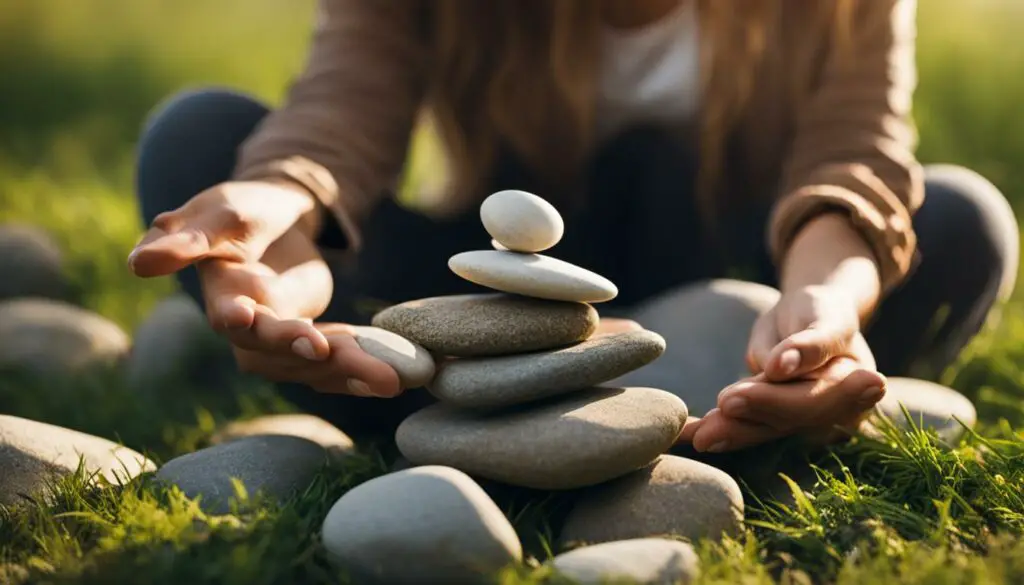
Incorporating Metal Element
The metal element is associated with qualities such as clarity, focus, and precision. To balance the metal element in your home, consider incorporating metal-inspired decor and colors.
Some tips for incorporating the metal element include:
- Add metal accents, such as bronze or stainless steel, to your decor.
- Use metal-framed mirrors or furniture.
- Introduce gray, white, or other metallic colors into your space.
- Hang metal wall art or sculptures.
- Choose furniture with metal legs or hardware.
Combining Elements
Remember, part of achieving feng shui equilibrium is finding the balance between all five elements. To avoid overwhelming your space with one particular element, consider combining them.
For example:
| Element Combination | Benefits |
|---|---|
| Wood and water | Enhances creativity and growth |
| Fire and metal | Promotes productivity and success |
| Earth and metal | Brings stability and nourishment |

By incorporating the metal element and finding the right balance between all five elements, you can create a harmonious and peaceful environment in your home.
Flowing with the Water Element
The water element is associated with calmness, flexibility, and abundance. Introducing water-inspired decor and colors into your home can create a sense of flow and harmony.
To balance the water element, consider adding a water feature such as a tabletop fountain or an aquarium. The sound of flowing water can soothe and relax the mind, while the visual element of water can enhance tranquility and peace.

Water Element Colors
| Color | Description |
|---|---|
| Blue | Calming and serene. It can promote relaxation and reduce stress. |
| Black | Mysterious and deep. It can add depth and contrast to a space. |
| White | Pure and cleansing. It can create a sense of clarity and peace. |
Another way to incorporate the water element is through art or decor featuring images of water, such as landscapes or seascapes. Using blue or black in textiles, such as curtains or throw pillows, can also add a calming water energy to a space.
- Consider adding a mirror to reflect the water element and enhance its energy in a space.
- Avoid placing water element decor or features in the bedroom, as it can create too much yin energy and disrupt sleep.
By incorporating the water element into your home, you can create a sense of flow, flexibility, and abundance. Use these tips and techniques to achieve balance and harmony in your living space.
Finding Balance and Harmony with Feng Shui
Now that you understand the characteristics of each element, it’s time to bring them together and find balance in your space. These feng shui balance tips will help you harmonize the five elements in your home and create a peaceful and balanced environment:
- Arrange furniture and objects in a way that optimizes the flow of energy.
- Introduce all five elements in each room, but emphasize the element(s) that promote the desired energy in that space.
- Use color to balance elements. For example, if the fire element dominates a room, add earth element colors like yellow or brown to balance it out.
- Don’t forget the importance of lighting! Introduce natural light and soft, warm lighting to create a relaxing and calming atmosphere.
Creating harmony with feng shui takes time and effort, but the results are worth it. By applying these feng shui principles, you can achieve an optimal flow of energy and bring balance and peace to your home.
Additional Tips:
For a quick and easy way to balance out any space, try adding a feng shui crystal. These crystals come in different colors that correspond to the five elements and can be placed throughout your home to create balance and harmony. They also add a beautiful decorative touch.
Another way to bring balance to your home is by incorporating plants. Plants represent the wood element and are great for purifying the air and promoting a sense of calmness and relaxation.
Remember, feng shui is not a one-size-fits-all approach. Experiment and adjust the balance of elements in your home until it feels just right for you. With time and practice, you can achieve a harmonious and balanced environment that promotes overall well-being.
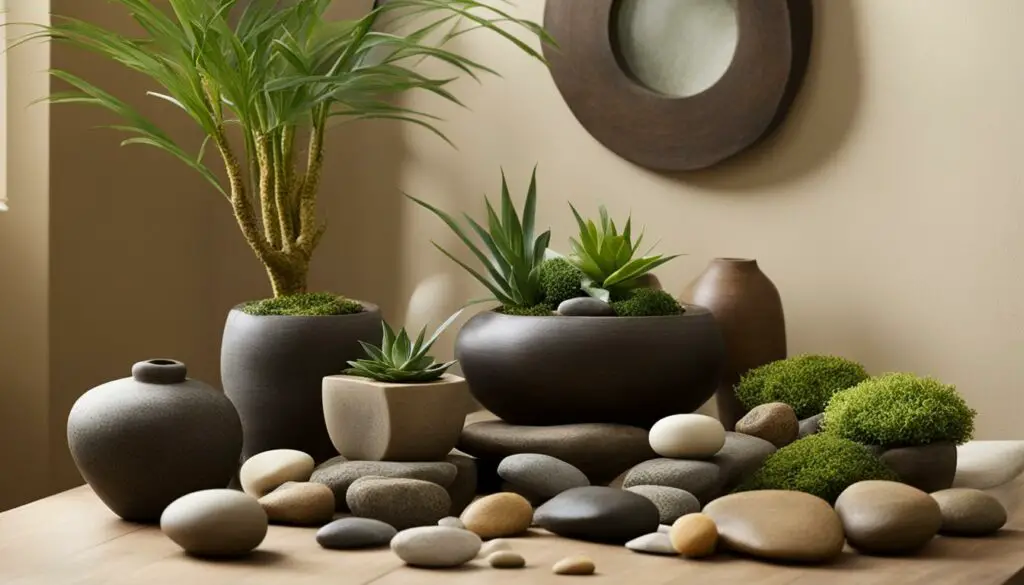
Feng Shui in Different Rooms
The principles of Feng Shui can be applied to all areas of your home to create a balanced environment that promotes positive energy flow. Each room has its own specific challenges and opportunities for achieving Feng Shui equilibrium. By understanding the unique characteristics of each room and how they interact with the five elements, you can create a harmonious living space that improves your overall well-being.
The Bedroom
The bedroom is a sanctuary for rest and relaxation. To create a balanced energy flow, it is important to place the bed in a commanding position with a solid headboard for support. Avoid placing the bed directly opposite the door. Use soft lighting, warm colors, and natural fabrics to create a cozy and inviting atmosphere. Incorporate elements of wood, fire, and earth to promote passion, intimacy, and grounding.
The Living Room
The living room is a central space for socializing and entertainment. To promote positive energy flow, arrange furniture in a way that encourages conversation and connection. Use vibrant colors, comfortable seating, and soft lighting to create a warm and welcoming atmosphere. Incorporate elements of wood, fire, earth, metal, and water to create a balanced and harmonious environment.
The Kitchen
The kitchen is a space for nourishment and sustenance. To create a balanced energy flow, organize your kitchen in a way that promotes ease of movement and efficiency. Use bright colors, natural materials, and ample lighting to create a clean and inviting atmosphere. Incorporate elements of fire, earth, metal, and water to promote nourishment, grounding, and flow.
The Bathroom
The bathroom is a space for cleansing and rejuvenation. To promote positive energy flow, keep the bathroom clean and well-organized. Use calming colors, soft lighting, and natural materials to create a spa-like atmosphere. Incorporate elements of water, wood, and earth to promote relaxation, renewal, and grounding.
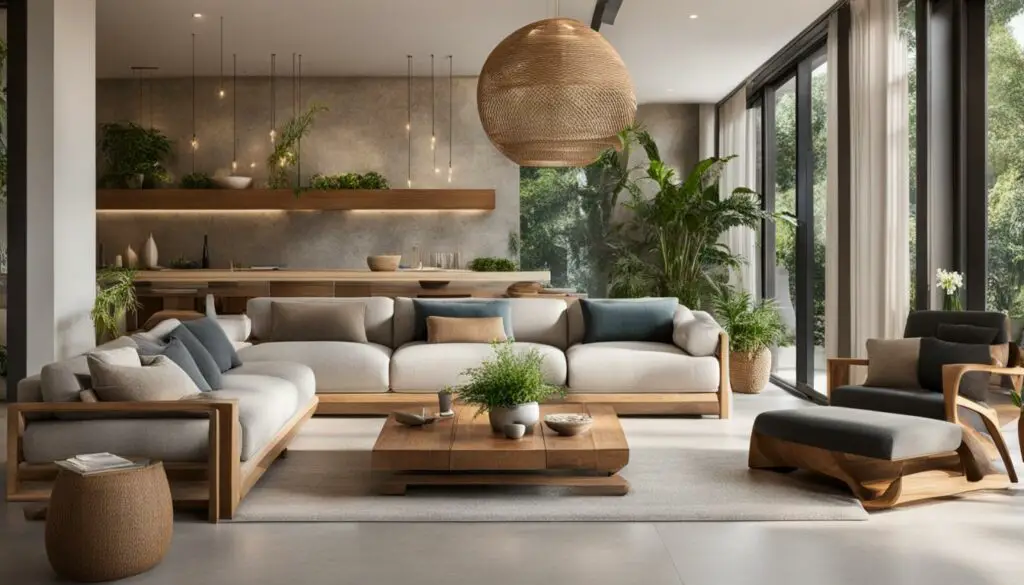
Clearing Clutter for Energy Flow
Clutter is one of the biggest hindrances to achieving a balanced Feng Shui environment. It disrupts the flow of energy and creates stagnant pockets of negative energy. To optimize the energy flow in your home, it’s essential to declutter regularly and clear out any unnecessary items.
Start by assessing each room in your home. Take note of any items that do not serve a practical or sentimental purpose. Go through your belongings and get rid of anything that doesn’t belong or brings negative emotions.
When decluttering, it’s important to be mindful of the items you’re keeping. Ensure that they have a designated place and that they contribute positively to the energy flow in your home. Avoid overcrowding your living space as it can create a sense of chaos and disarray.
Decluttering Tips:
- Start small and focus on one area at a time.
- Use storage containers to keep items organized.
- Avoid keeping objects under your bed, as it can disrupt the energy flow.
Decluttering can be a daunting task, but it’s a crucial step towards achieving a harmonious and balanced Feng Shui environment. By clearing out the old and making space for the new, you’re inviting positive energy and abundance into your home.
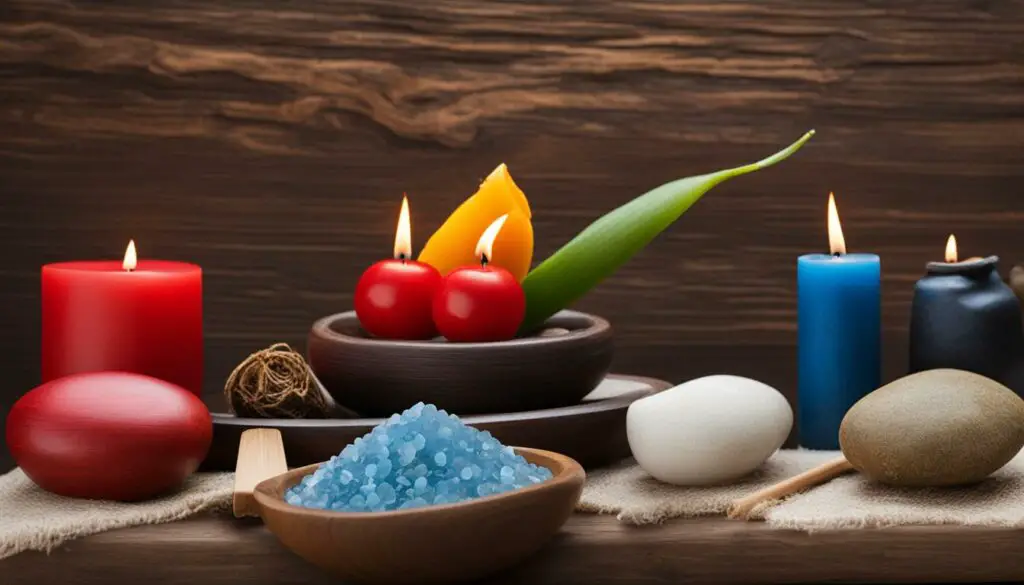
“The space in which we live should be for the person we are becoming now, not for the person we were in the past.” – Anonymous
Enhancing the Feng Shui Energy Map
Once you have assessed your living space and balanced the five elements, it’s time to take your Feng Shui practice to the next level by enhancing the energy map. The Bagua, or Feng Shui energy map, divides your home into nine different sectors or guas, each representing a different aspect of your life, such as wealth, relationships, and health. By mapping out these areas and making adjustments, you can promote positive energy flow and bring balance and harmony to your home.
To enhance the Feng Shui energy map, start by determining the Bagua of your home. Stand at the front door facing inwards and imagine a three-by-three grid layered over your living space. The bottom left square represents wealth, the middle square is fame, and the top right square is relationships. Continue mapping out the remaining squares, including family, health, creativity, knowledge, career, and helpful people.
Each sector should be enhanced with corresponding colors, objects, and elements to manifest the desired energy. For example, to promote wealth and prosperity, incorporate shades of green and purple as well as wood and water elements into the wealth sector. To enhance relationships, use pairs of objects, such as two candles or two statues, and incorporate the color pink or red as well as earth and fire elements into the relationships sector.
Remember, a balanced and harmonious Feng Shui energy map requires maintaining a balanced Feng Shui environment. Ensure that each sector is clutter-free and well-lit, and that the elements are in balance throughout your living space.

Expanding Feng Shui Practices
Now that you have achieved a balanced Feng Shui environment, it’s time to expand your practices and take it to the next level. Here are some advanced tips to help you reach Feng Shui equilibrium and maintain positive energy flow in your space:
Bring in Natural Elements
Embrace the power of nature and bring in natural elements to your living space. This can include plants, natural stones, and even a small indoor water fountain. These elements can help purify the air, reduce stress, and promote relaxation.
Create a Scentscape
Scents can have a powerful effect on your mood and energy. Use essential oils or incense to create a scentscape that promotes focus, relaxation, or creativity. Some scents to try include lavender for relaxation, peppermint for focus, and citrus for energy.
Activate the Wealth Corner
The wealth corner, located in the southeast corner of your home, is believed to be connected to abundance and prosperity. Activate this corner by adding elements such as a plant, a green rug, or a vase of fresh flowers. This can help attract wealth and abundance into your life.
Use Feng Shui Jewelry
Wearing Feng Shui jewelry can help you carry positive energy with you throughout the day. Look for pieces that incorporate the five elements or feature symbols of peace, harmony, and balance.
Consider Feng Shui Art
Art can be a powerful tool in promoting positive energy flow in your home. Look for art that features the five elements or incorporates symbols of balance and harmony. Consider using colors that correspond to the different elements.

By expanding your Feng Shui practices, you can further enhance the balance and harmony in your living space. These advanced tips can help you achieve Feng Shui equilibrium and maintain a positive energy flow in your home.
Conclusion
Now that you have learned how to balance Feng Shui elements in your home, you can create a harmonious and peaceful environment that promotes well-being and positivity. Remember to assess your space and identify areas that require balance, then incorporate the five elements of Feng Shui – wood, fire, earth, metal, and water – to harmonize the energy flow.
To optimize the flow of energy, declutter your space, arrange objects and furniture strategically, and use the Bagua energy map to enhance balance and harmony. Don’t be afraid to expand your Feng Shui practices by incorporating natural elements, embracing the power of scent, and exploring advanced techniques.
Transform Your Living Space
By following these tips and techniques, you can tap into a serene lifestyle and experience the transformative power of Feng Shui. Create a sanctuary of balance, peace, and well-being in your home, and enjoy the positive energy and harmony that comes with it.
FAQ
What is Feng Shui?
Feng Shui is an ancient Chinese practice of arranging your living space to create a harmonious flow of energy. It involves utilizing principles and techniques to bring balance and peace into your home.
What are the five elements in Feng Shui?
The five elements in Feng Shui are wood, fire, earth, metal, and water. Each element represents different energies and plays a significant role in influencing the energy flow in your home.
How do I assess my space for Feng Shui?
Assessing your space for Feng Shui involves evaluating your home’s energy and identifying areas that require balance. You can also consider the principles of yin and yang to create harmony by balancing opposing forces.
How can I balance the wood element in my home?
Balancing the wood element in Feng Shui can be achieved by incorporating wood element objects and colors into your living space. This helps create a balanced and harmonious environment.
How can I harness the power of fire in Feng Shui?
You can harness the power of fire in Feng Shui by incorporating fire-inspired decor and colors into your home. This creates warmth and passion, adding vibrant energy to your living space.
How can I ground my space with the earth element?
Grounding your space with the earth element in Feng Shui involves using earth element colors, materials, and shapes. These elements bring stability and nourishment to your living environment.
How do I incorporate the metal element in Feng Shui?
Incorporating the metal element in Feng Shui can be done by introducing metal element colors, objects, and textures into your home. This enhances clarity, focus, and precision in your living space.
How can I flow with the water element in Feng Shui?
To flow with the water element in Feng Shui, you can incorporate water-inspired decor and colors. This brings a sense of flow, flexibility, and abundance into your home.
How can I find balance and harmony in Feng Shui?
Finding balance and harmony in Feng Shui involves harmonizing the five elements in your space. You can arrange objects and furniture to optimize the flow of energy, creating a harmonious and peaceful environment.
How can I apply Feng Shui principles to different rooms in my home?
Applying Feng Shui principles to different rooms in your home requires specific tips and techniques. From the bedroom to the kitchen, you can balance the elements in each space to promote relaxation, productivity, and overall well-being.
Why is decluttering important in Feng Shui?
Decluttering is important in Feng Shui as it allows energy to flow freely. By eliminating clutter, you create a clearer and more balanced energy flow in your space.
What is the Bagua in Feng Shui?
The Bagua is the Feng Shui energy map used to enhance balance and harmony in your space. It helps you map out the different areas of your home and make adjustments to optimize the energy flow in each sector.
